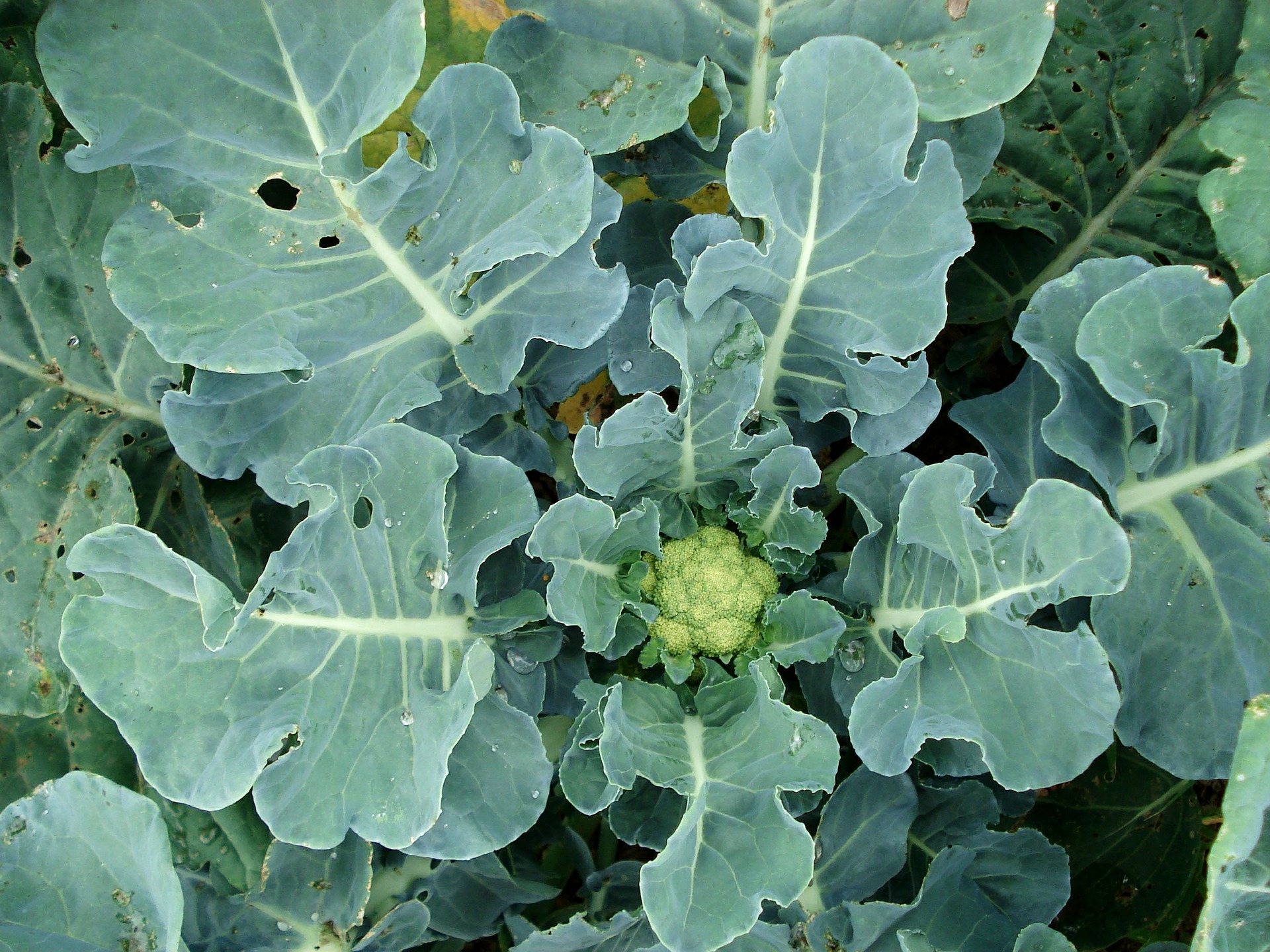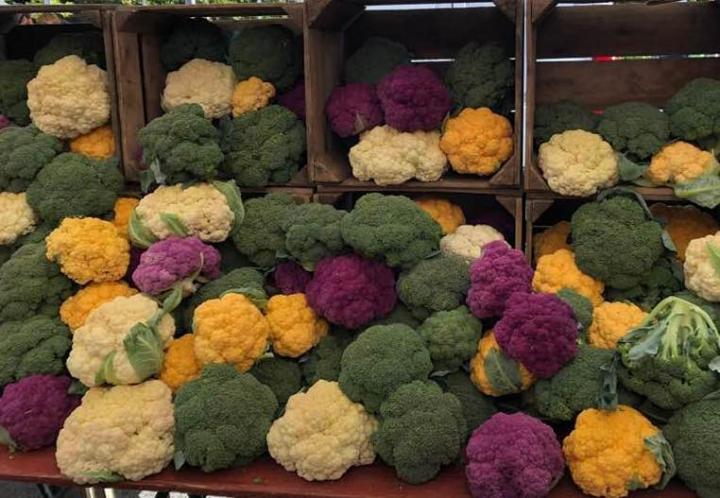Cauliflower is a sun-loving, cool-season crop to grow in spring and fall. An annual plant in the Brassica family, cauliflower’s edible white flesh is extremely healthy and considered a “superfood.”
About Cauliflower
This vegetable’s name comes from the Latin words caulis, for cabbage, and floris, for flower. It’s a descendent of wild cabbage! Like its cousin broccoli, the tightly bunched florets of cauliflower are connected by a thick core, often with a few light leaves surrounding it.
Though usually white, cauliflower does come in other colors including purple, yellow, and orange. No matter the color, the taste is the same: mild, slightly sweet, a little nutty.
Cauliflower can be a challenge for the beginner gardeners because it requires consistently cool temperatures with temperatures in the 60°Fs. Otherwise, it may prematurely “button”—form small, button-size heads—rather than forming a single, large head.
When to Plant Cauliflower
- Cauliflower grows best as a fall crop, but can be grown in spring, too.
- We recommend buying cauliflower seedlings (aka “transplants”) versus starting them from seed, as cauliflower can be finicky.
- Spring Planting:
- If you start from seed, sow seeds indoors 4 to 5 weeks before the last spring frost date. Sow in rows 3 to 6 inches apart and up to 1/2 of an inch deep. Water consistently during germination and growth.
- Plant seedlings outdoors 2 to 4 weeks before the last spring frost date.
- Fall Planting:
- Plant a fall crop 6 to 8 weeks before the first fall frost date but after daytime temperatures are regularly below 75°F.
- Shade plants from the hot summer sun, if necessary.
Choosing and Preparing the Planting Site
- Soil needs to be very rich in organic matter; mix aged manure and/or compost into the bed before planting.
- As an alternative, apply 5-10-10 fertilizer to the planting site. Fertile soil holds in moisture to prevent heads from “buttoning.”
How to Plant Cauliflower
- Set plants 18 to 24 inches apart with 30 inches between rows.
- In early spring, be ready to protect plants from frost by covering them with old milk jugs, if necessary. Extreme cold can halt growth and/or form buttons.
- Add mulch to conserve moisture.

How to Grow Cauliflower
- Cauliflower dislikes any interruption to its growth. Change, in the form of temperature, moisture, soil nutrition, or insects, can cause the plants to develop a head prematurely or ruin an existing one.
- Water regularly with 2 inches of water per square foot each week; even with normal rainfall, this usually requires supplemental watering.
- For best growth, side-dress the plants with a high-nitrogen fertilizer 3 t o 4 weeks after transplanting.
- Note that the cauliflower will start out as a loose head and that it takes time for the head to fully form. Many varieties take at least 75 to 85 days from transplant. Be patient!
- Brown heads indicate a boron deficiency in the soil. Drench with 1 tablespoon of borax in 1 gallon of water. (Avoid getting boron on other plants.) Or, provide liquid seaweed extract immediately; repeat every 2 weeks until symptoms disappear. In the future, add more compost to the soil.
- For white varieties, pink heads can indicate too much sun exposure or temperature fluctuations. Purple hues can be due to stress or low soil fertility.
Blanching Cauliflower Heads
When the curd (the white head) is 2 to 3 inches in diameter, blanch it: Tie the outer leaves together over the head and secure with a rubber band, tape, or twine to keep light out. (This is not necessary for self-blanching or colored varieties). The plants are usually ready for harvest 7 to 12 days after blanching.
| Pest/Disease | Type | Symptoms | Control/Prevention |
|---|---|---|---|
| Aphids | Insect |
Curled, misshapen/yellow leaves; distorted flowers/fruit; sticky “honeydew” (excrement); sooty, black mold |
Grow companion plants; knock off with water spray; apply insecticidal soap; put banana or orange peels around plants; wipe leaves with a 1 to 2 percent solution of water and dish soap (no additives) every 2 to 3 days for 2 weeks; add native plants to invite beneficial insects (such as ladybugs) |
| Black rot | Fungus | Yellow, V-shape areas on leaf edges that brown and progress toward leaf center; leaves eventually collapse; stem cross sections reveal blackened veins | Destroy infected plants; choose resistant varieties; provide good drainage; remove plant debris; rotate crops |
| Cabbage loopers | Insect | Large, ragged holes in leaves from larval feeding; defoliation; stunted or bored heads; excrement | Handpick off plants; add native plants to invite beneficial insects; spray larvae with insecticidal soap or Bacillus thuringiensis (Bt)—a natural, bacterial pesticide; use row covers; remove plant debris at end of season |
| Cabbage root maggots | Insect | White maggots become gray flies that resemble small houseflies. Wilted/stunted plants; off-color leaves; larvae feeding on roots | Use collars made of plastic or tin foil around seedling stems; monitor adults with yellow sticky traps; use row covers; destroy crop residue; till soil in fall; rotate crops |
| Cabbageworms | Insect | Leaves have large, ragged holes or are skeletonized; heads bored; dark green excrement; yellowish eggs laid singly on leaf undersides | Handpick; use row covers; add native plants to invite beneficial insects; grow companion plants (especially thyme); spray Bt (Bacillus thuringiensis) |
| Clubroot | Fungus | Wilted/stunted plants; yellow leaves; roots appear swollen/distorted | Destroy infected plants; solarize soil; maintain soil pH of around 7.2; disinfect tools; rotate crops |
| Downy Mildew | Fungus | Yellow, angular spots on upper leaf surfaces that turn brown; white/purple/gray cottony growth on leaf undersides only; distorted leaves; defoliation | Remove plant debris; choose resistant varieties; ensure good air circulation; avoid overhead watering |
| Nitrogen deficiency | Deficiency | Bottom leaves turn yellow and the problem continues toward the top of the plant | Supplement with a high nitrogen (but low phosphorus) fertilizer or blood meal. Blood meal is a quick nitrogen fix for yellowing leaves |
| Stink bugs | Insect | Yellow/white blotches on leaves; shriveled seeds; eggs, often keg-shape, in clusters on leaf undersides | Destroy crop residue; handpick (bugs emit odor, wear gloves); destroy eggs; spray nymphs with insecticidal soap; use row covers; weed; till soil in fall |
| Thrips | Insect | Leaves, especially in folds near base, have white patches or silver streaks; brown leaf tips; blistering/bronzing on leaves; brown streaks on cauliflower curds; heads distorted or stunted; curling or scarring | Remove plant debris; choose resistant varieties; add native plants to invite beneficial insects; use row covers; use straw mulch; monitor adults with yellow or white sticky traps; use sprinklers or other overhead watering |
| White rust | Fungus | Chalk-white blisters mainly on leaf undersides; small, yellow-green spots or blisters, sometimes in circular arrangement, on upper leaf surfaces; possible distortion or galls; flowers/stems may also be infected. More common with warm days and cool/moist nights. | Destroy infected plants; choose resistant varieties; weed; destroy crop residue; rotate crops |
- ‘Graffiti’: purple; tends to be milder and sweeter than the white varieties.
- ‘Snowball’: smooth, white, medium 6-inch heads; a good yield throughout the growing season.
- Orange varieties, such as ‘Cheddar’ and ‘Flame Star’, are creamier and sweeter than white varieties with more vitamin A.
 Cauliflower at a farm stand in Washington, D.C., 2019. Credit: Wendy Hagen.
Cauliflower at a farm stand in Washington, D.C., 2019. Credit: Wendy Hagen.
How to Harvest Cauliflower
- Plants are usually ready to harvest in about 50 to 100 days, depending on variety, or 7 to 12 days after blanching.
- When the heads are compact, white, and firm, then it is time to harvest them. Ideally, the heads will grow to 6 to 8 inches in diameter.
- Cut the heads off the plant with a large knife. Be sure to leave some of the leaves around the head to keep it protected.
- If the heads are too small, but have already started to open up, they will not improve and should be harvested immediately.
- If the cauliflower has a coarse appearance, it is past maturity and should be tossed.
How to Store Cauliflower
- Store heads in a plastic bag in the refrigerator. They should last for about a week.
- For long-term storage, you can also freeze or pickle the heads. To freeze, cut into 1-inch-bite pieces. Blanch for 3 minutes in lightly salted water. Cool in an ice bath for 3 minutes, drain, and package. Seal and freeze.
Cauliflower is nothing but cabbage with a college education.
-Mark Twain (1835-1910)




